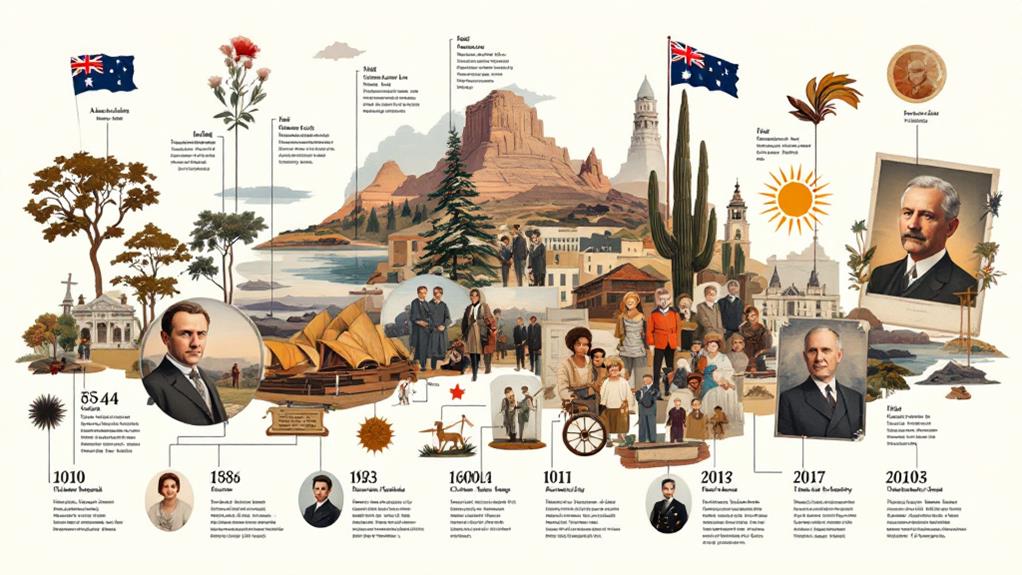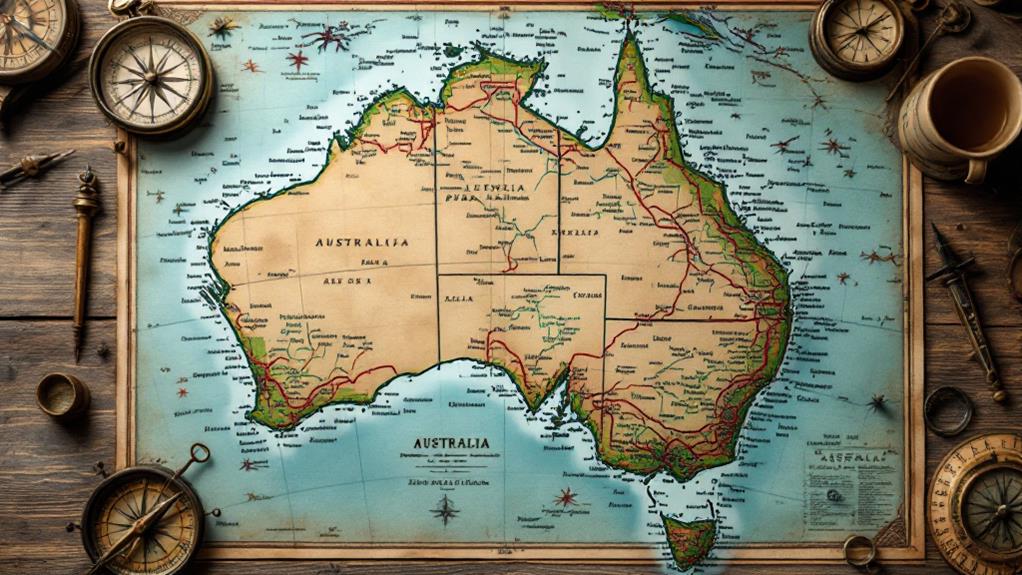When Did Australia Become a Country? Federation and Nationhood Explained

Australia became a country on January 1, 1901, when six British colonies—New South Wales, Victoria, Queensland, South Australia, Western Australia, and Tasmania—united to form the Commonwealth of Australia. This significant event, known as Federation, followed years of economic inefficiencies, the need for a national defense, and the desire for self-governance. The Australian Constitution, approved by the British Parliament, outlined the powers of the federal and state governments, establishing a federal system. The inaugural federal Parliament opened on May 9, 1901, marking the birth of Australia's national government. There's more to uncover about how nationhood shaped its identity.
Historical Background of Federation
Australia's Federation, a vital moment in the nation's history, became a reality on January 1, 1901, when six British colonies united to form a single nation. These colonies—New South Wales, Victoria, Queensland, South Australia, Western Australia, and Tasmania—came together under the Commonwealth of Australia Constitution, approved by the British Parliament. This monumental step addressed economic inefficiencies caused by separate colonial tariffs and the need for a unified national government.
Sir Henry Parkes played a significant role in this transformation. His influential Tenterfield Oration in 1889 rallied public support, emphasizing unity among the six British colonies. Parkes' vision laid the groundwork for a series of conventions and constitutional referendums from 1891 to 1900, which ultimately drafted the Commonwealth of Australia Constitution Act. The approval by the British Parliament on July 5, 1900, was a key milestone in this expedition.
The initial federal Parliament opened on May 9, 1901, in Melbourne, marking the official establishment of Australia's national government. This new federal system aimed to improve governance and representation, ensuring that the newly formed nation could efficiently tackle its challenges and opportunities.
Key Drivers for Unification
The push for unification of the Australian colonies was driven by several crucial factors that underscored the need for a cohesive national government. By the late 1800s, these British colonies were operating independently, leading to inefficiencies in trade and defense. Sir Henry Parkes' 1889 Tenterfield address was instrumental, highlighting the necessity of a national defense force and the removal of interstate tariffs. The economic depression exacerbated these issues, as tariffs increased goods' costs and hindered inter-colonial trade. Free traders saw the solution in a unified market under a federal government.
The Federation movement gained momentum as national sentiment rose. By 1888, 70% of the population was Australian-born, fostering a collective desire for self-governance and unification. This desire was further fueled by the anti-immigration sentiment of the late 19th century, particularly against non-British migrants. The colonies recognized the need for a coordinated immigration policy, which could only be effectively managed by a national government.
While the unification efforts didn't directly address the rights and representation of Aboriginal and Torres Strait Islander peoples, the drive for a cohesive national identity was clear. Unification was seen as crucial for addressing economic, social, and defense challenges effectively.
Process and Milestones

Initiating the voyage to federation, Australia navigated through a series of essential events that shaped its nationhood. The expedition began with the National Australasian Convention in 1891, where a draft constitution for federation was crafted, laying the groundwork for a unified national government. This draft was vital for the establishment of the Commonwealth of Australia, officially formed on January 1, 1901. The British Parliament's passing of the Commonwealth of Australia Constitution Act on July 5, 1900, was a significant milestone in this process.
A series of referendums between 1898 and 1900 played a critical role in the approval of the Australian Constitution. Although initially not passed by New South Wales, a second referendum ultimately led to its acceptance, allowing the constitution to be ratified across all participating colonies. Following this, the initial federal election was held, setting the stage for the inauguration of the Parliament of the Commonwealth.
On May 9, 1901, over 12,000 guests witnessed the opening of the inaugural federal Parliament in Melbourne. This historic event marked the formal establishment of Australia's national government, with the primary Prime Minister leading the newly formed nation.
Role of the Australian Constitution
Following the foundational events that led to federation, you can appreciate the significant role the Australian Constitution plays in shaping the nation. Coming into effect on January 1, 1901, the Constitution marked the official establishment of the Commonwealth of Australia. This essential document outlines the framework for governance by defining the distribution of powers between the federal government and state parliaments.
The Constitution also established the High Court of Australia, which interprets its provisions and guarantees the separation of powers is maintained. This separation is vital in preventing any one branch of government from becoming too powerful, thereby supporting the principle of responsible government. Furthermore, the Constitution safeguards citizens' rights, including religious freedom, guaranteeing a balanced and fair society.
The Constitution's progression began with approval by the British Parliament through the Commonwealth of Australia Constitution Act on July 5, 1900, and it received royal assent from Queen Victoria shortly thereafter. As you reflect on its importance, consider these key elements:
- Framework for governance: Defines federal and state powers.
- High Court: Guarantees constitutional interpretation.
- Citizens' rights: Protects freedoms and rights.
- Separation of powers: Maintains balance within the government.
Impact on Governance and Identity

Australia's expedition to nationhood transformed its governance and identity. By adopting the Australia Constitution Act on January 1, 1901, the nation changed from colonial rule to a federal system, establishing the Commonwealth of Australia. This shift marked a new period in governance, where the division of powers between the federal and state governments was clearly outlined. The newly formed framework guaranteed that issues such as defense, trade, and immigration could be managed more effectively across the unified nation.
The opening of the initial federal Parliament on May 9, 1901, symbolized the operational start of this national government, capable of addressing nationwide concerns. Despite becoming a self-governing dominion, Australia retained ties to the British Crown, with the monarch serving as the head of state. This arrangement reflected a balance between local governance and imperial loyalty, allowing Australia to maintain its connections to British heritage while fostering its own national identity.
The progression towards Federation also nurtured a sense of unity among Australians, who began to see themselves as part of a shared heritage. This burgeoning national identity was an essential component in defining Australia's place on the world stage, beyond individual colonial boundaries.




